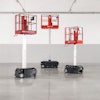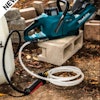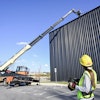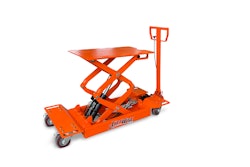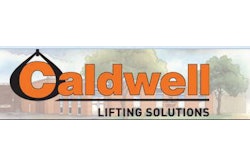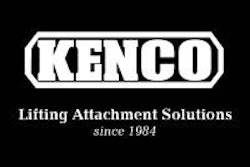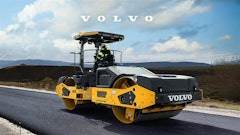Steel chains, cables and slings are a popular way to lift everything from concrete barriers to pipe to rip rap. They're simple to use and initially cost effective to purchase. But if you're moving a lot of material, they're also slow and labor intensive.
"For a one-shot deal, chains and straps can be economical," says Tracy Black, Kenco. "But if you're working on a project such as a shoreline or canal where you have to place thousands of rocks, boulders, rip rap, etc., using an attachment such as a mechanical grapple is easier and faster."
A wide array of lifting attachments are available for skid steers, wheel loaders, excavators, cranes, etc., to make handling hard to move material easier, more productive and safer. And even in today's economic environment, pursuing the extra expenditure can make sense.
"As businesses are trying to reduce overall costs, they need to be more productive in every job they do," says Theresa Dittbenner, The Caldwell Group. "Lifting attachments can help do that. Previously, you may have needed three to four workers to do one specific lifting task. We can take it down to two. That helps reduce the overall cost involved in that particular process. You can also redirect those two workers to a different portion of the jobsite to speed up the process - and some companies sign contracts with bonuses for jobs completed ahead of schedule."
Attachment options
Pallet forks are one of the more basic types of lifting attachments.
Danuser Machine Co., Inc. offers forks that enable skid-steer loaders to move stacked material such as sod, bricks, wood, etc. "Having pallet forks is like having a forklift on your jobsite or at your business," says Glenn Danuser. "Our forks are designed with a strong brick guard to help prevent materials from rolling backward toward the operator. [The design] helps keeps the materials out front, so you can precisely put them where you would like."
In addition to clamp-on bucket forks, The Caldwell Group offers weld-on bucket hooks for craning tasks. "You don't have to disconnect the bucket from the machine, or bring in a crane to do lifting," says Dittbenner. "You can utilize one piece of equipment to be more versatile on the job."
Pipe hooks are also relatively simple and economical. They insert inside the pipe so they can accommodate a wide variety of pipe sizes. "You don't have to dig a ditch wider than the pipe," says Black. "That can become important if you're working in tight areas like a trench box."
Specialized lifting attachments available include Kenco's Barrier or Pipe Lifts, The Caldwell Group's Barrier Lift Grab, Pipe Hook and Beam Lifter and Vacuworx's RC Model lifters. Such attachments can enhance productivity by enabling pipe, barrier wall, I-beams and other objects to be moved quickly compared to traditional methods.
With a strap or chain, you need to pinpoint the object's exact center. "You have to be dead in the middle to lift it level," Black explains. "Otherwise, it can slip or hang crooked, which makes something like pipe more difficult to install.
"[Kenco's] lifters are designed so you don't have to be exactly in the center of the object to lift effectively," he points out. "That speeds lifting because you don't have to find a balance point. You don't have to take time to measure to find the exact center point."
With chains and straps, you also need to get underneath the intended object to wrap all the way around it. This isn't required with many specialized lifting attachments.
"Our lifters only go about three-quarters of the way around an object, so you're not affecting the pipe once you place it in the ditch. It never touches the gravel," says Black. "With a strap, when you pull the strap to remove it, you can also unintentionally displace the gravel, which you then need to go back and fix."
Increase safety
"Contractors today are faced with ever-growing demands for a safer jobsite," comments Shawn Lowman, Vacuworx. "Meeting those demands can be difficult with the rising costs of doing business."
Lift attachments offer a cost-effective means to enhance safety when moving pipe or other materials. "You don't have anyone moving underneath the pipe," Dittbenner notes. "With a sling, if it isn't engaged in the correct position on the pipe, there's potential that the pipe could slide and slip out."
Vacuworx's lifting attachments feature a closed-frequency wireless remote control system that allows the equipment operator to maneuver the material with great precision, and with no additional personnel required. "Not only can the contractor save by reducing his workforce, but in many cases, a reduced insurance rate can be obtained due to the lack of any ground personnel in harm's way," Lowman asserts.
"By addressing the major concern of safety, we afford the contractor the ability to reduce his workforce, lower his insurance cost and actually speed up the process of material handling," he adds. "In the end, this equates to a safe work environment and increased profits."
Reduce costs
Equipment such as barrier lifters feature polyurethane pads that are gentler on the object being moved.
"This helps increase the life of a barrier wall, because it reduces or eliminates damage," says Dittbenner. "Every time you pick up and move a barrier with a chain sling, you damage the concrete. The chains are steel and they dig in, plus you're carrying the whole weight of the load on that chain. This results in wear that requires barriers to be replaced more often. With a barrier grab, the pads reduce damage, so the barrier will last longer to reduce long-term replacement costs."
Pipe integrity has become a major focus for the federal regulatory organizations, adds Lowman. "The use of chains, slings and hooks causes damage to pipe coatings, causing the contractor additional time and labor to repair the damage," he says. "Our Vacuworx Lifting System eliminates the problem of damaged coatings. All of our lifting pads utilize a special seal material to protect the coating from any damage, while providing a secure and safe lift."
Because many lift attachments are fully or partially automatic, less personnel is typically needed. In addition, some don't require the use of hydraulics.
"With many of our lifts, no one has to touch the item being moved," says Black. "And because they don't require hydraulics, they're less expensive."
Several manufacturers also offer custom designs and sizes to accommodate various materials. "There's really no limitation as to what we can design for," says Dittbenner.

